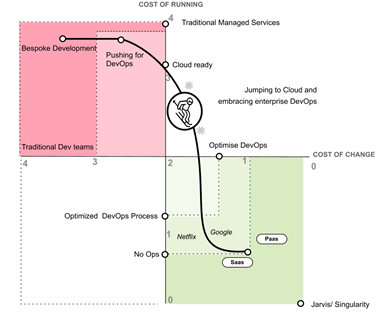It’s hard to believe that space travel is over 60 years old. So much has changed throughout that time, as you would expect across 60 years of innovation. Where technology was single use, rockets and their parts jettisoned after serving their purpose, organisations like SpaceX are reusing their technology investments. Astonishingly, SpaceX have reused their rockets an incredible 143 times. Two of the biggest advantages this approach takes is the reduced speed-to-market and cost of operating. And it’s these two benefits that just happen to share with something else that didn’t exist 60 years ago – DevOps.
Rather than looking to land a successful space mission, DevOps is there to help businesses land and maintain successful modernisation journeys. In this article, we will explore the factors that can help a business maximise the return on its digital investment.
What is DevOps?
DevOps is the fusing together of two technical functions – development and operations. Rather than having developer engineers do their part then hand it over to operations experts, the two collaborate throughout the project lifecycle, which covers build and implementation support.
Utilising DevOps methodologies enables businesses to rapidly increase the speed of delivery and decrease the risk at which they deliver value to customers. Where the traditional, siloed engineering approach to developing a solution and having it available for end users in Production took anywhere from one month to three years, high-performing DevOps teams can develop and implement multiple releases every day.
Three terms commonly associated with DevOps are continuous integration, delivery, and deployment:
What is continuous integration?
Continuous integration is the process of merging software development changes with the main branch as frequently as possible. It is the process of establishing and maintaining a quality engineering and testing base practice pathway, which includes automated tests against the build.
What is continuous delivery?
Continuous delivery builds upon continuous integration by deploying code changes into testing and/or production environments on request. This practice sees teams creating software in short cycles to deliver more reliable releases, at greater speed, and at a higher frequency.
What is continuous deployment?
Continuous deployment is the DevOps benchmark, where changes are automatically deployed to customers, assuming they pass the required tests. This means clean, resilient, and robust code is deployed into production without human intervention. It's remarkable to see in action.
Considering the speed at which DevOps enables an organisation to release new digital platforms and products, it should come as no surprise that it is one of the pillars of leading enterprise modernisation programmes.
Two key factors to consider before undergoing a modernisation programme
When planning out an enterprise modernisation programme, there are two important aspects to consider before charging ahead:
Cost of Change (CoC)
The cost of change is one of the main forces of resistance that slows down organisation from implementing new features, upgrades, or fixes. Organisations need to consider the costs associated with implementing such projects, including costs incurred from other departments, new processes required, and the time to take these releases to market.
Cost of Running (CoR)
All organisations have a technology-related cost of running, which typically includes Managed Services, IT Ops, Application Support, L1/L2 support, and BAU team each fit into this category. These are the costs related to run and maintain software.
Understanding these two factors can help you identify how great the need is to move your organization to a DevOps model, as well as what is the cost to your business if you don’t.
Visualising DevOps in an enterprise modernisation programme
One way to visualize what successful modernisation programmes look like is with a ski jump, which like a SpaceX rocket, also requires a perfect landing. By plotting CoC and CoR on a chart, organisations typically fall into specific parts of the graph, which has a resemblance to a ski jump.

In the graph above, you can see organisations with mature DevOps practices are in the green zone. They have taken significant steps to reduce the cost of running and the cost of change, and whose teams are each likely able to make multiple releases per day. The pinnacle would be to reach the point where cost of running and cost of change are both zero. This is something that we will discuss in a future post.
DevOps Capability Assessment. We have a service to not just plot where your business is but give you a plan on getting deep into the green zone and transitioning into a high-performing DevOps organisation. Find out more about that here.
Our next article will dive into what it means to be at various points of the modernisation ski jump and how your organisation move into the desired green zone.
